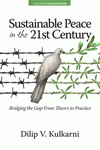
Sustainable Peace in the Twenty‐First Century
Bridging the Gap from Theory to Practice
A volume in the series: Peace Education. Editor(s): Laura L. Finley, Barry University.
Published 2017
“Why haven’t we been successful in finding sustainable solutions?” is a question that this book attempts to address. This book questions the appropriateness of current approaches to international conflict mediation/peacebuilding and whether today’s practitioners have the necessary patience, passion, and training to manage twenty‐first‐century conflicts. This book also examines whether the current approaches to the mediation of international conflict and peacebuilding, as well as the education in these fields, effectively consider the influence of the post‐Cold War environment and whether they address sub‐national conflicts caused by the continually increasing social inequality within societies, among parties with different cultural, religious, racial, ethnic, and linguistic backgrounds.
The narratives of the lived experiences of this book’s contributors are used to illustrate the challenges associated with achieving sustained global peace in the twenty‐first century. Using the author’s conversations with the contributors to the book, as well as educators, this book suggests that a universally adopted answer to the book’s underlying question has not yet been established. Therefore, the objective of this book is to start a public conversation about reforming the current education and practices used in the mediation of international conflicts and peacebuilding. The author hopes that these reforms will enable practitioners in integrating the message of the youth uprisings across the globe in finding sustainable resolutions to social inequality–based conflicts within their societies and among countries across the globe.
As all of the citizens of the world continue to live in the midst of conflicts erupting across the globe, this book brings to the surface the urgent and acute need for finding better approaches to address this century’s social inequality‐based conflicts. This book seeks to bring hope and to energize individuals with different cultural, religious, ethnic, racial and linguistic backgrounds, as well as individuals with different professional and personal lived experiences to collaboratively work together to achieve sustainable global peace. The author hopes that this book will foster among students, educators, and practitioners a better understanding of international conflict mediators’ approaches for accommodating the inter‐relationship between culture and the mediation of international conflicts.
CONTENTS
Peace Education Series Introduction. Preface. CHAPTER I: Challenges for Achieving Sustainable Global Peace in the 21st Century. CHAPTER II: Constraints and Inadequacies of Current Practices and Future Needs. CHAPTER III: Culture and Conflicts in the 21st Century. CHAPTER IV: How Mediation and Peacebuilding Practices Are Impacted by the Evolving Dynamics of International Conflicts. CHAPTER V: How Life Experiences of Mediators and Peacebuilders Come Into Play. CHAPTER VI: Changing Practices—Needed Structural and Practice Reforms. CHAPTER VII: Educating and Training Future Practitioners. CHAPTER VIII: Other Critical Challenges to Achieving Global Peace. CHAPTER IX: Empowering a “Greatest Generation” for the 21st Century. References. About the Contributing Mediators.
-
Paperback9781681237497
Web price: $45.04 (Reg. 52.99)
-
Hardcover9781681237503
Web price: $80.74 (Reg. 94.99)
- eBook9781681237510

- EDU008000 - EDUCATION: Decision-Making & Problem Solving
- POL000000 - POLITICAL SCIENCE: General
- EDU034000 - EDUCATION: EDUCATIONAL POLICY & REFORM: General
-
 Coronavirus and Vulnerable People
Addressing the Divide in Harm and Responses and Exploring Implications for a More Peaceful World
Coronavirus and Vulnerable People
Addressing the Divide in Harm and Responses and Exploring Implications for a More Peaceful World
-
 Experiential Learning in Higher Education
Issues, Ideas, and Challenges for Promoting Peace and Justice
Experiential Learning in Higher Education
Issues, Ideas, and Challenges for Promoting Peace and Justice
-
 Humanities Perspectives in Peace Education
Re-Engaging the Heart of Peace Studies
Humanities Perspectives in Peace Education
Re-Engaging the Heart of Peace Studies
-
 Lessons for Creating a Culture of Character and Peace in Your Classroom
A Playbook for Teachers
Lessons for Creating a Culture of Character and Peace in Your Classroom
A Playbook for Teachers
-
 Peace is Everyone's Business
Peace is Everyone's Business
-
 Teaching Peace Through Popular Culture
2nd Edition
Teaching Peace Through Popular Culture
2nd Edition
-
 The New Peace Linguistics and the Role of Language in Conflict
The New Peace Linguistics and the Role of Language in Conflict

